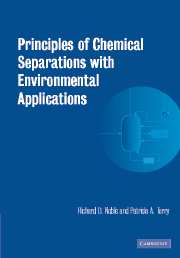Book contents
- Frontmatter
- Contents
- Preface
- 1 Introduction
- 2 Separations as unit operations
- 3 Separations analysis fundamentals
- 4 Distillation
- 5 Extraction
- 6 Absorption and stripping
- 7 Adsorption
- 8 Ion exchange
- 9 Membranes
- Appendix A Dimensionless numbers
- Appendix B Mass transfer coefficient correlations
- Appendix C Pulse analysis
- Appendix D Finite difference approach
- Appendix E Bibliography of chemical separations and related physical properties
- References
- Index
9 - Membranes
Published online by Cambridge University Press: 26 December 2009
- Frontmatter
- Contents
- Preface
- 1 Introduction
- 2 Separations as unit operations
- 3 Separations analysis fundamentals
- 4 Distillation
- 5 Extraction
- 6 Absorption and stripping
- 7 Adsorption
- 8 Ion exchange
- 9 Membranes
- Appendix A Dimensionless numbers
- Appendix B Mass transfer coefficient correlations
- Appendix C Pulse analysis
- Appendix D Finite difference approach
- Appendix E Bibliography of chemical separations and related physical properties
- References
- Index
Summary
A wide screen just makes a bad film twice as bad.
– SAMUEL GOLDWYNObjectives
Identify the three major driving forces for membrane separations.
Define permeability, permeance, selectivity, and rejection.
List the transport mechanisms for membrane separations.
List some environmental applications of each type of membrane separation.
Describe the advantages and disadvantages of membrane technology.
Membrane definition
A membrane can be defined as [1]:
… a semi-permeable barrier between two phases. This barrier can restrict the movement of molecules across it in a very specific manner. The membrane must act as a barrier between phases to prevent intimate contact. This barrier can be solid, liquid, or even a gas. The semi-permeable nature is essential to insuring that a separation takes place. If all species present could move through the membrane at the same rate, no separation would occur. The manner in which the membrane restricts molecular motion can take many forms. Size exclusion, differences in diffusion coefficients, electrical charge, and differences in solubility are some examples. A membrane separation is a rate process. The separation is accomplished by a driving force, not by equilibrium between phases.
There are three important points to note with respect to this definition. First, a membrane is defined by what it does (function), not by what it is. So, a wide range of materials are potentially useful as membranes. Second, the membrane separation mechanism is not specified. So, again there could be several choices.
- Type
- Chapter
- Information
- Publisher: Cambridge University PressPrint publication year: 2004



